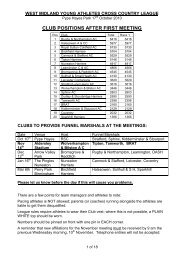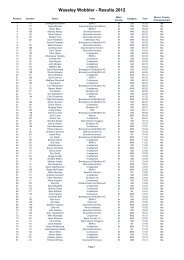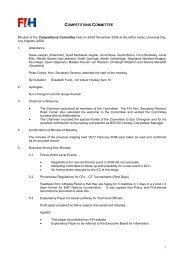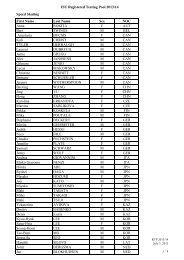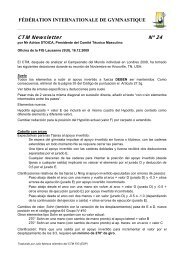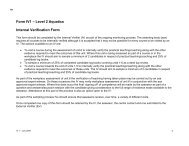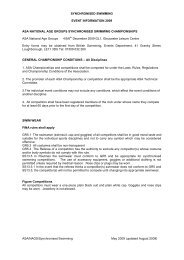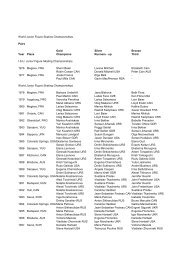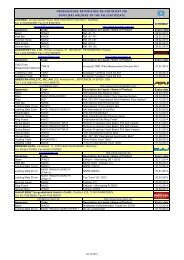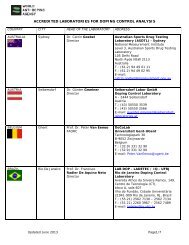ASA/UKCC Level 2 Certificate for Coaching Diving - FIG
ASA/UKCC Level 2 Certificate for Coaching Diving - FIG
ASA/UKCC Level 2 Certificate for Coaching Diving - FIG
You also want an ePaper? Increase the reach of your titles
YUMPU automatically turns print PDFs into web optimized ePapers that Google loves.
Element 3 – Planning and EvaluationTo achieve this element the candidates must be able to:U2.3.1 Explain the planning processU2.3.2 Identify in<strong>for</strong>mation required to plan a sessionU2.3.3 Explain the different needs of a range of participantsU2.3.4 Identify appropriate methods to collect review and analyse participants’ needsU2.3.5 Identify guidelines <strong>for</strong> dealing with confidential in<strong>for</strong>mationU2.3.6 Identify alternative activities as appropriate to meet changing needs of participants and theteaching/coaching environmentU2.3.7 Explain the purpose and value of evaluationU2.3.8 Identify evaluation methods that can be used to monitor development and learning <strong>for</strong>participants, self and othersU2.3.9 Identify the opportunities <strong>for</strong> evaluation of self and othersSyllabus:Planning• The Planning Process: e.g. schemes of work, planning <strong>for</strong> a week/term/year, session plans• In<strong>for</strong>mation Required to Plan: e.g. session outcomes, participants, resources, contentboundaries, health and safety, timings, duration, technical content, linked activities• Range of Participants: e.g. beginners, expert, children, elderly, needs• Needs of Participants: e.g. appropriate activities, intensity, environment, additional support• Methods to Collect In<strong>for</strong>mation: questioning, written <strong>for</strong>ms, discussion, in<strong>for</strong>mation fromothers, feedback• Dealing with In<strong>for</strong>mation: data protection, disclosure of in<strong>for</strong>mation• Planning <strong>for</strong> Self and Others: flexibility; adaptation; improvisation; range of participants;different individual’s needsEvaluation• Purpose and Value of Evaluation: e.g. feedback on per<strong>for</strong>mance (participant andteacher/coach), future development, future planning• Methods of Evaluation: e.g. discussion with participants, peer review, self reflection,technologies (video)• Opportunities <strong>for</strong> Evaluation: e.g. previous session, agreed observations, feedbackopportunities, self review, participants per<strong>for</strong>manceElement 4 – Teacher’s/Coach’s Tool BoxTo achieve this element the candidate must be able to:U2.4.1 Identify the stages of Long Term Athlete Development (LTAD)U2.4.2 Describe the impact that LTAD has on the teaching/coaching processU2.4.3 Explain the need to refer participant(s) who cannot be supported within the currentteaching/coaching environmentU2.4.4 Identify and explain the stages within the teaching/coaching cycleU2.4.5 Identify preferred teaching/coaching philosophy and teaching/coaching style <strong>for</strong> selfSyllabus:Effective Teaching/<strong>Coaching</strong>• The Teaching/<strong>Coaching</strong> Cycle: prepare, plan, deliver, monitor, evaluate• Teaching/<strong>Coaching</strong> Styles: autocratic e.g.- telling and selling, democratic e.g.- sharing andallowing, laissez-faire, understanding personal teaching/coaching philosophyLong Term Athlete Development• LTAD: FUNdamentals, skill development, training to train; competitive development,per<strong>for</strong>mance• Impact of LTAD on the teaching/coaching process: teaching/coaching process, participantreferralPage 7



